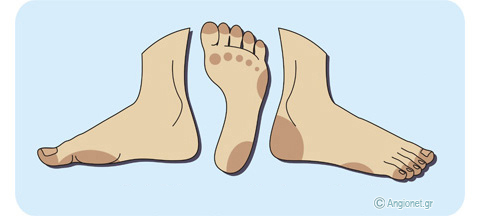- Why do my feet need special attention?
- What do I generally need to do?
- How should I look after my feet?
Why do my feet need special attention?
Diabetes mellitus (DM) damages certain nerves to the feet and hands (diabetic neuropathy) and may cause:
- loss of feeling, tingling and pain in your feet. These sensations normally protect and warn you of injuries to your feet
- muscle weakness and foot deformity (neuropathic arthropathy)
Diabetes also makes the arteries which supply your legs with blood more susceptible to hardening, a condition called peripheral occlusive arterial disease, which may reduce the blood flow to your feet.
The above conditions put you at higher risk for developing leg ulcers.
In Greece, 10% of the population suffers from DM. It is estimated that 15% of all diabetics will develop a foot ulcer during their lifetime, usually on the sole of the foot or the toes. Almost 20% (14-24%) of diabetics with a foot ulcer will require an amputation (Intersociety Consensus for the Management of Peripheral Arterial Disease [TASC II]. “European Journal of Vascular & Endovascular Surgery”, [suppl.1] Vol.33, 2007).
What do I generally need to do?
There are certain changes in your life-style which should improve your health and help you remain healthy.
- Stop smoking completely, if you are a smoker
- Have a healthy diet low in animal fat, take small and frequent (every three hours) meals or snacks, maintain your body weight at normal levels and exercise regularly
- Monitor your blood sugar several times a day, as your doctor has recommended
How should I look after my feet?
Check your feet EVERY DAY – Look for any cuts, blisters, sores, redness or swelling of your feet, ankles and between the toes. If you can’t see the soles, use a mirror or ask someone else to check them. If there is anything abnormal, consult your doctor.
Wash your feet EVERY DAY – Wash your feet with soap and lukewarm – not hot – water. Do not let them soak. Dry carefully with a soft towel and especially between the toes.
Moisturize your feet to keep the skin smooth and soft – Apply a fine layer of moisturizing cream (usually based on lanolin) every day to prevent dryness and cracking of the skin, avoiding the areas between the toes which should be kept dry.
Do not try to treat yourself – If you develop calluses or other abnormal foot skin conditions, do not apply dressings, creams etc. Ask your doctor immediately even if there is no pain. The recommended strategy today is regular podiatric management for routine care of calluses.
Cut your nails straight and not round – Use a nail trimmer carefully trying not to irritate the skin. If you have difficulties, ask someone else to help you. If your nails get thick, yellowed or are growing into your skin, call your doctor.
ALWAYS wear shoes and socks – even in the house to prevent injuries. Socks should fit well and not have a seam. Change socks every day. Do not walk barefoot. Remember to check the inside of your shoes before putting them on to make sure nothing is in them that could injure your foot and that the linings are smooth.
Buy shoes that fit properly – Be very careful with new shoes and wear them only for short periods initially. Shoes that do not fit well may cause blisters and sores. Be sure that your shoes are snug enough so that your feet don’t slip in them, but leave enough room for you to wiggle your toes. Buy rounded shoes with low (preferably 2-3 cm) heels. Wide shoes that don’t compress your toes are best and you should avoid wearing open-toe or open-heel shoes. You may also see a Podiatrist to supply you with custom-made shoes.
Protect your feet from heat or cold – ALWAYS wear shoes on hot pavement. Avoid sitting or lying with your feet near radiators and do not place heating pads or hot water bottles on your feet. Wear socks to protect your feet from cold. During cold weather, check your feet regularly to monitor for frostbite.
Try to maintain good circulation to your feet – Wiggle your toes and flex your feet and ankles for 5 minutes 2 to 3 times each day. Remember not to cross your legs for long periods of time. Avoid tight-fitting socks and garters, which might cause swelling or pressure injuries.
Exercise regularly – Exercise improves circulation as well as overall health. Activities like walking, dancing, swimming, and cycling are all activities that will improve your overall health but minimize stress to your feet. Be sure to check with your doctor before beginning an exercise program.
Last modified 22/02/2014







